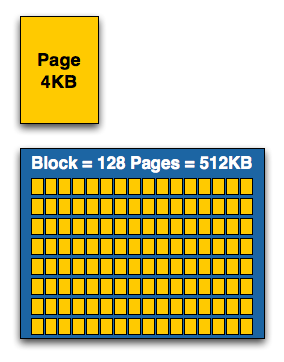The SSD Anthology: Understanding SSDs and New Drives from OCZ
by Anand Lal Shimpi on March 18, 2009 12:00 AM EST- Posted in
- Storage
The Anatomy of an SSD
Let’s meet Mr. N-channel MOSFET again:

Say Hello
This is the building block of NAND-flash; one transistor is required per cell. A single NAND-flash cell can either store one or two bits of data. If it stores one, then it’s called a Single Level Cell (SLC) flash and if it stores two then it’s a Multi Level Cell (MLC) flash. Both are physically made the same way; in fact there’s nothing that separates MLC from SLC flash, it’s just a matter of how the data is stored in and read from the cell.

SLC flash (left) vs. MLC flash (right)
Flash is read from and written to in a guess-and-test fashion. You apply a voltage to the cell and check to see how it responds. You keep increasing the voltage until you get a result.
| SLC NAND flash | MLC NAND flash | |
| Random Read | 25 µs | 50 µs |
| Erase | 2ms per block | 2ms per block |
| Programming | 250 µs | 900 µs |
With four voltage levels to check, MLC flash takes around 3x longer to write to as SLC. On the flip side you get twice the capacity at the same cost. Because of this distinction, and the fact that even MLC flash is more than fast enough for a SSD, you’ll only see MLC used for desktop SSDs while SLC is used for enterprise level server SSDs.

Cells are strung together in arrays as depicted in the image to the right
So a single cell stores either one or two bits of data, but where do we go from there? Groups of cells are organized into pages, the smallest structure that’s readable/writable in a SSD. Today 4KB pages are standard on SSDs.
Pages are grouped together into blocks; today it’s common to have 128 pages in a block (512KB in a block). A block is the smallest structure that can be erased in a NAND-flash device. So while you can read from and write to a page, you can only erase a block (128 pages at a time). This is where many of the SSD’s problems stem from, I’ll repeat this again later because it’s one of the most important parts of understanding SSDs.

Arrays of cells are grouped into a page, arrays of pages are grouped into blocks
Blocks are then grouped into planes, and you’ll find multiple planes on a single NAND-flash die.

The combining doesn’t stop there; you can usually find either one, two or four die per package. While you’ll see a single NAND-flash IC, there may actually be two or four die in that package. You can also stack multiple ICs on top of each other to minimize board real estate usage.










250 Comments
View All Comments
Hrel - Thursday, April 9, 2009 - link
although, I have some issues which I have put in an e-mail sent to Anand; can't wait for you response.Hrel - Thursday, April 9, 2009 - link
Instead of making me dinner can you send me that test system instead??? Please!!!Hrel - Thursday, April 9, 2009 - link
I was wondering what controller the OCZ solid Series is based on??? Will I experience hiccups with that drive or not? Is the point of my question.sfisher64 - Wednesday, April 8, 2009 - link
I just purchased a Dell Latitude E6400 with a 64GB Ultra Performance Solid State Drive. Does anyone know what type of drive this is, and where it fits in the spectrum described in this article?Baffo - Saturday, April 11, 2009 - link
The Dells use the Samsung drives (you should see this on the bottom if you pull it out). However, as much as I wish this was one of the newer controllers (I have a few of these at work as well), the testing cycles demanded by Dell probably mean these are the older controllers.marraco - Tuesday, April 7, 2009 - link
This article is popular :)BLHealthy4life - Monday, April 6, 2009 - link
Intel 9.1.1.1010 (Intel) Where are these drivers? I can only find version 1007 and not 1010....Thanks
BLHealthy4life - Sunday, April 12, 2009 - link
found it....Intel obviously keeps the X58 chipset drivers current for their own boards, just not other mfgs boards....
They installed fine on my R2E..
BL
irondukes - Friday, April 3, 2009 - link
Hi-- Do SLCs suffer from performance degradation, or are the controllers pretty agressive at erasing the data since they have far longer read-write cycles? Please help! Deciding between an X25E and X25Mmdavies - Friday, April 3, 2009 - link
I'm reading this about a day late - got my Patriot PE256GS25SSDR 2.5" 256GB yesterday since I'm bad about destroying hard drives. this drive, in a word, was excruciating. I'll be replacing it with one of your recommended drives today.Thanks